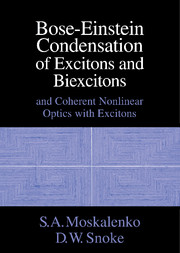Book contents
- Frontmatter
- Contents
- Preface
- 1 Introduction
- 2 Basic Theory of Bose–Einstein Condensation of Excitons
- 3 The Interaction of Condensed Excitons with Lattice Phonons
- 4 Bose–Einstein Condensation of Biexcitons
- 5 Phase Transitions and Thermodynamics of High-Density of Excitons
- 6 The Optical Stark Effect and the Virtual Bose Condensate
- 7 Bose–Einstein Condensation of Mixed States of Excitons and Photons
- 8 Nonequilibrium Kinetics of High-Density Excitons
- 9 Coherent Nonlinear Optics with Excitons
- 10 New Directions
- Appendix A: Properties of Excitons in Cu2O
- Author Index
- Subject Index
1 - Introduction
Published online by Cambridge University Press: 04 August 2010
- Frontmatter
- Contents
- Preface
- 1 Introduction
- 2 Basic Theory of Bose–Einstein Condensation of Excitons
- 3 The Interaction of Condensed Excitons with Lattice Phonons
- 4 Bose–Einstein Condensation of Biexcitons
- 5 Phase Transitions and Thermodynamics of High-Density of Excitons
- 6 The Optical Stark Effect and the Virtual Bose Condensate
- 7 Bose–Einstein Condensation of Mixed States of Excitons and Photons
- 8 Nonequilibrium Kinetics of High-Density Excitons
- 9 Coherent Nonlinear Optics with Excitons
- 10 New Directions
- Appendix A: Properties of Excitons in Cu2O
- Author Index
- Subject Index
Summary
What is an Exciton?
Many people seem to have trouble with the concept of an exciton. Is it “real” in the same sense that a photon or an atom is? Does the motion of an exciton correspond to the transport of anything real in a solid?
Simply put, an exciton is an electron and a hole held together by Coulomb attraction. Of course, for some people the idea of a “hole” is a difficult concept, so this may not help much. Nevertheless, a hole is a “real” particle and so is an exciton.a Modern solid-state theory [1,2] gives equal footing to both free electrons and holes as charge carriers in a solid, exactly analogous to the way that electrons and positrons are both “real” particles, even though a positron can be seen as the absence of an electron in the negative-energy Dirac sea, i.e., a backwards-in-time-moving electron.
All excitons are spatially compact. The strong Coulomb attraction between the negatively charged electron and the positively-charged hole keeps them close together in real space, unlike Cooper pairs, which can have very long correlation lengths because of the weak phonon coupling between them. The sizes of excitons vary from the size of a single atom, e.g., approximately an angstrom up to several hundred angstroms, extending across thousands of lattice sites. Excitons are roughly divided into two categories based on their size. An exciton that is localized to a single lattice site is called a “Frenkel” exciton, after the pioneering work of Frenkel [3] on excitons in molecular crystals. Frenkel excitons appear most commonly in molecular crystals, polymers, and biological molecules, in which they are extremely important for understanding energy transfer.
- Type
- Chapter
- Information
- Bose-Einstein Condensation of Excitons and BiexcitonsAnd Coherent Nonlinear Optics with Excitons, pp. 1 - 28Publisher: Cambridge University PressPrint publication year: 2000
- 1
- Cited by



